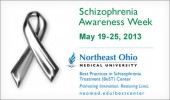The past few weeks have been a whirlwind of wonderful interaction with people in treatment for mental illness and those who are part of their community of recovery. I will write more about the stories, struggles and solutions I've heard in Louisiana, Michigan, Tennessee, and (soon) Ohio, but right now I want to share the wonderful list from the BeST (Best Practices in Schizophrenia Treatment) Center at the Northeast Ohio Medical University. I'll be meeting some families there on Thursday before I provide the keynote for NAMI Summit County's Annual Dinner, and I can't wait.
Meanwhile, I found this list of tips on their website, and it's a great summary of some of the tips you can find here on HealthyPlace.com. As Schizophrenia Awareness week approaches, families need all the tips we can get - and to know we are not alone in this fight to aid awareness and advocate.
Early Detection is important in schizophrenia, and the more families and practitioners I meet, the more I am convinced that "Early education and support" matters a great deal for families, so they can become prepared to help as best they can. Otherwise, the confusion and frustration can result in families who end up just giving in to the frustration. So, in that spirit and with thanks, I share this list.
[caption id="attachment_1446" align="alignleft" width="170" caption="Looking Forward to This Visit"] [/caption]
[/caption]
Best Practices in Schizophrenia Treatment (BeST) Center
BUILDING ON FAMILY STRENGTHS: SUPPORT, EDUCATION AND ADVOCACY
GUIDELINES FOR FAMILY MEMBERS/SIGNIFICANT OTHERS
1. GO SLOWLY. Recovery takes time. Rest is important. It’s important to see the value of small, positive steps.
2. KEEP IT COOL. Enthusiasm is normal, but keep it toned down.
Disagreements are normal, but keep these toned down too.
3. BE GENTLE AND WARM. Family bonds are meaningful and important. Stay connected. Use kind words. Try to be nurturing, respectful, supportive and loving – but not detached.
4. GIVE EACH OTHER SPACE. Time out is important for everyone. It’s okay to say “no.” Allow your relative space and time when he or she needs it.
5. SET LIMITS. Everyone needs to know what the rules are. Set a few good
rules to keep things clear.
6. IGNORE WHAT YOU CAN’T CHANGE. Let some things slide, but don’t
ignore violence or threats.
7. KEEP IT SIMPLE. Say what you have to say in a clear, calm and positive
manner.
8.
FOLLOW THE TREATMENT PLAN. This is an action plan for treating mental illness. If
medication, family psychoeducation and/or other interventions are part of the
treatment plan, then follow this plan to aid recovery.
9. CARRY ON BUSINESS AS USUAL. Re-establish family routines as quickly as possible. Stay in touch with family and friends.
10. TAKE CARE OF YOURSELF. Families need to take care of themselves too. It’s difficult to care for and/or support someone else if you are not taking good care of yourself. It’s important to ‘recharge’ your own batteries.
11. PICK UP ON EARLY WARNING SIGNS. Develop a list of early warning
signs that may indicate your relative is relapsing. Note these changes.
Discuss these signs with your family member and his or her provider in
order to prevent a relapse.
12. SOLVE PROBLEMS STEP-BY-STEP. Follow a step-by-step process to
resolve concerns.
13. SET REALISTIC EXPECTATIONS. Be gentle and understanding. Stress is unhealthy for everyone, including your relative and you. Keep expectations of yourself and your loved one manageable.*
*Adapted by the BeST Center from the Family Institute for Education, Practice & Research, a partnership between the New York State Office of Mental Health and the University of Rochester Medical Center, in collaboration with the Conference of Local Mental Hygiene Directors and the National Alliance on Mental Illness – New York State.
Anderson, et al., 1986; McFarlane, 2002. Used with permission.
 [/caption]
[/caption]